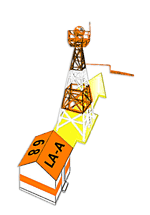 |
||||||
|
||||||
Concrete Ground Arrow Design |
||||||
Concrete Arrows were designed by the Department of Commerce Lighthouse - Airways Division as a navigational aid to help keep Air Mail Pilots on course while flying the night segments of the airways. They were part of a beacon station located every 10 or 15 miles along the airway. Each beacon station was numbered with the smaller number to the west or south. The concrete arrow pointed to the next higher number on the airway. They were primarily a day mark to help pilots navigate across the countryside, at night they just flew the line of blinking lights. They also allowed the pilot to know where they were on the airway if they became lost. The first airway light beacon erected by the Aeronautics Branch began operation on December 7, 1926. The beacon was located 15 miles northeast of Moline, Ill., on the Chicago-Dallas air mail route. By June 30, 1927, there were 4,121 miles of lighted airways, including 2,041 miles on the transcontinental airway that had been previously lighted by the Post Office Department. Arrows were usually a standard length of 57 feet, and 11 feet wide. They had 5 sections:
They had a 9-inch black border painted around the arrow to add contrast and visibility.
|
||||||
Top View of Concrete Arrow |
||||||
Cross Section of Beacon Pad |
||||||
|
||||||
Side View of Concrete Arrow |
||||||
|
||||||
Department of Commerce Lable |
||||||
Original Diagram of Ground Directional Arrow |
||||||
Courtesy of Steve Owen, from the book, "By the Seat of Their Pants". Written by H. Dale Heister |
||||||
You can also make comments and share photos on our Facebook Page at:Arrows Across America
|
||||||
| Alabama | Arizona | Arkansas | California | Colorado | Connecticut | Delaware | Florida | Georgia | Idaho | Illinois | Indiana | Iowa | Kansas Kentucky | Louisiana | Maine | Maryland | Massachusetts | Michigan | Minnesota | Mississippi | Missouri | Montana | Nebraska | Nevada New Hampshire | New Jersey | New Mexico | New York | North Carolina | North Dakota | Ohio | Oklahoma | Oregon | Pennsylvania Rhode Island | South Carolina | South Dakota | Tennessee | Texas | Utah | Vermont | Virginia | Washington | West Virginia | Wisconsin | Wyoming |





